德国KOCO螺柱焊机焊接培训
螺柱焊培训
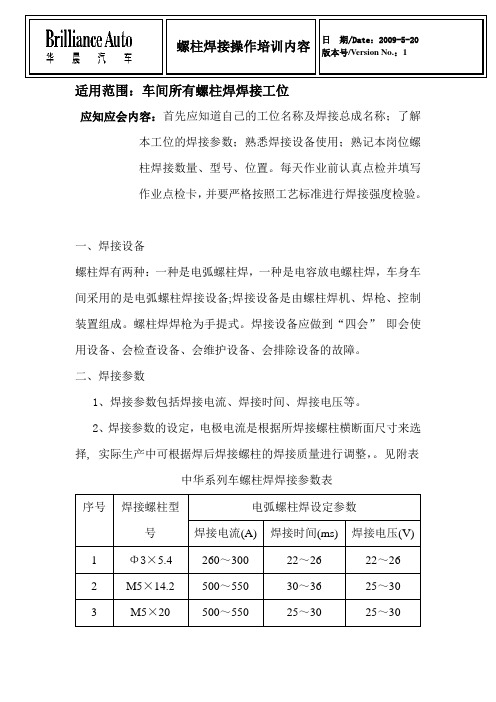
适用范围:车间所有螺柱焊焊接工位应知应会内容:首先应知道自己的工位名称及焊接总成名称;了解本工位的焊接参数;熟悉焊接设备使用;熟记本岗位螺柱焊接数量、型号、位置。
每天作业前认真点检并填写作业点检卡,并要严格按照工艺标准进行焊接强度检验。
一、焊接设备螺柱焊有两种:一种是电弧螺柱焊,一种是电容放电螺柱焊,车身车间采用的是电弧螺柱焊接设备;焊接设备是由螺柱焊机、焊枪、控制装置组成。
螺柱焊焊枪为手提式。
焊接设备应做到“四会” 即会使用设备、会检查设备、会维护设备、会排除设备的故障。
二、焊接参数1、焊接参数包括焊接电流、焊接时间、焊接电压等。
2、焊接参数的设定,电极电流是根据所焊接螺柱横断面尺寸来选择, 实际生产中可根据焊后焊接螺柱的焊接质量进行调整,。
见附表中华系列车螺柱焊焊接参数表三、作业前点检1、焊接设备点检焊接设备应处于正常的工作状态,焊枪喷嘴上无飞溅的焊渣;枪嘴位于焊枪中心,卡套的夹紧力和清洁程度是否良好;用样板检测1.2mm的拉弧距离;焊枪后部的保护盖应拧紧;自动送料设备要完好,连接处无松动;发现异常及时通知相关人员解决,并做好点检记录。
2、工装夹具检点每天工作前应对工装夹具进行检查,内容包括夹具定位销和支撑面要求无磨损、不松动;夹具垫片要求紧固;导套不松动,与焊接面垂直,夹紧装置有足够夹紧力,确保工件不动,保证焊接位置准确,发现异常及时通知相关人员解决,并填写点检记录表。
3、工件的检查工作前应对冲压件进行检查,要求工件表面应清洁无油污、杂质和锈蚀,无变形,发现问题及时与上序和冲压件负责人员联系解决。
四、焊接操作1、将焊接螺柱安装在焊枪上(或自动送料);2、夹具定位并夹紧;3、施加压力使焊接螺柱垂直紧贴工件表面;4、扣压焊枪上的扳机开关——焊接;5、提起焊枪、松开夹具;五、焊接质量点检焊接后,用呢绒棒检查螺柱倾斜弯曲强度,要求倾斜角度≥150以每个螺柱焊缝和热影响区都没有肉眼可见的开裂视为合格,确认合格后将螺柱复位,焊接螺柱位置、数量、规格正确;螺柱根部焊缝均匀、完好;螺柱垂直于工件表面;做到每件必检,检验结果填写到《螺柱焊日常自检记录表》中,班段长在日常生产过程中,检验频次为,每班2 次,并做好记录。
螺柱焊机等离子焊接培训
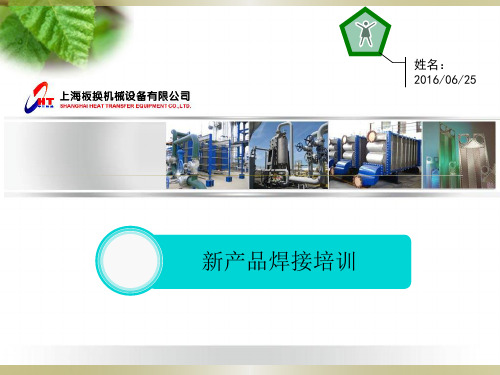
板框式热交换器的焊接
② 电弧稳定性好,由于微束等离子弧焊采用联合弧,电流小 至0.1A时电弧仍能稳定燃烧,因此可以焊接超薄件,如 0.1mm厚的不锈钢; ③ 电弧挺值度好,以焊接电流10A为例,等离子弧焊喷嘴高 度(喷嘴到工件表面的距离)达到6.4mm时,弧柱仍较挺直, 而钨极氩弧焊的弧长仅能达到0.6mm(弧长大于0.6mm时稳定 性变差)。钨极氩弧焊的扩散角约为45°,呈圆锥形,工件 上的加热面积与弧长成平方关系,只要电弧长度有很小的变 化将引起单位面积上输入热量的较大变化。而等离子弧的扩 散角约为5°左右,基本上是圆柱形,弧长变化对工件上的 加热面积和电流密度影响较小,所以等离子弧焊弧长对焊缝 成形的影响不明显。
空气预热器的焊接
六、焊接缺陷示例 1、法兰盘与母材之间有间隙 产生的原因: ①压力不够 ②母材太薄,背面无支撑 ③功率不合适
空气预热器的焊接
2、围绕焊缝由大量的飞溅 产生的原因: ①压力太低 ②功率过高 3、偏焊 产生的原因: ①电弧偏吹(一根地线易引起电弧偏吹) ②加压的顶针与螺柱不同心 ③焊枪与工件不垂直
板框式热交换器的焊接
④ 由于等离子弧焊枪的钨极内缩在喷嘴之内,电极不可能与 工件接触,因而没有焊缝夹钨的问题。 氩弧焊相比,熔透法等离子弧焊具有以下缺点: ① 由于电弧直径小,要求焊枪喷嘴轴线更准确的对中焊缝; ② 焊前结构复杂,加工精度高。焊枪喷嘴对焊接质量有着直 接影响,必须定期检查、维修,及时更换。
空气预热器的焊接
三、电容放电尖端接触螺柱焊特点 1、焊接时间短,只有1~3ms,空气来不及侵入焊接区,焊 接接头已经形成,因此无需气体保护。 2、螺柱直径d与被焊工件壁厚δ之比可以达到8~10,最小 板厚为0.5mm。 3、不用考虑螺柱长度的焊接收缩量,只是因为焊接熔池很 小,而且接头时塑性接头。 4、接头没有外部可见的焊脚,不需要进行接头外观质量检 查,不会有气孔、裂纹等缺陷。
螺柱焊设备机构及原理培训

5.3.7换车型时,如需推动焊枪,必须轻推,以防焊枪碰撞其他物品;
5.3.8发生故障时,应报班长,系长并通知有关维修人员,修复后方可使用。
32
谢谢
• THANK YOU!
5.3操作内容:
5.3.1操作人员须经培训后才能上岗;
5.3.2开机之前,进行例行点检;
5.3.3开关机之间的时间间隔必须10秒以上;
5.3.4正式焊接之前,必须检查每支焊枪是否自动飞出螺钉;
5.3.5进行手动送钉时,勿将枪头对准人,慎防螺钉伤人;
5.3.6操作时,切勿将手伸进送料器,以免机器运转时伤人;
偏弧, 单边熔
接
螺柱焊接NG
螺柱熔合部份偏向一侧, 另一侧存在部分不熔合 现象
对策1:调整作业角 度,植钉套筒角度
验证
对策2:检查是否存 在磁偏吹现像
28
焊装螺柱焊设备机构及原理培训
• 螺柱焊的常见品质NG与调整
螺柱焊接NG
由于压持力度不够 导致 气孔的出现 造成螺柱芯部存在 不熔合现象
对策:调整作业姿 势,检查焊枪内部
• Iw=焊接面直径(mm) x 110 A • tw=Iw x 0.04 ms • 以上值为参考值,可根据实际焊接效果微调(电流调幅:
±50A/次,时间调幅:±1~2ms/次)
Iw或tw不够
正好
过大
24
焊装螺柱焊设备机构及原理培训
• 螺柱焊的常见品质NG与调整
螺柱焊接OK
熔接外圈 铁水均匀
分布
熔接背面 无针孔或
穿孔
25
焊装螺柱焊设备机构及原理培训
• 螺柱焊的常见品质NG与调整
螺柱焊接OK
26
焊装螺柱焊设备机构及原理培训
koco螺柱焊机使用说明书

Operating ManualKÖCO Compact Stud Welding EquipmentELOTOP8021002170220023002KÖCO Stud Welding GunsCLASSICSK 12K 22K 22-DK 24K 26This operating manual has the part-no. 399-0212-000Declaration of Conformity ECProducer:Köster & Co. GmbHSpreeler Weg 32EnnepetalD-58256Designation of Product: Stud welding equipment series ELOTOP 802 to 3002 withstud welding gun series CLASSIC SK 12 to K 26The above mentioned equipment complies with the requirements of the following directives:Directive 98/37/EC relating to machineryDirective 73/23/EEC amended by 93/68 relating to electrical equipment designed for use within certain voltage limitsDirective 89/336/EEC amended by 91/263/EEC, 92/31/EEC and 93/68/EEC relating to electromagnetic com-patibilityThe above mentioned products observes the following European Standards and therefore compliy with the above mentioned directives:EN 60 204-1 “Electrical equipment of machines“EN 60 974-1 “Safety requirements of arc welding equipment“EN 50 199 “Electromagnetic compatibility - Product standard for arc welding equipment“Köster & Co. GmbHSpreeler Weg 32D-58256 EnnepetalEnnepetal, 2002-04-02SignatureTable of ContentsOperating Manual KÖCO Compact Stud Welding Equipment ELOTOP 802 1002 1702 2002 3002 1 KÖCO Stud Welding Guns CLASSIC SK 12 K 22 K 22-D K 24 K 26 1 Declaration of Conformity EC 2 Table of Contents 3 1Introduction 5 1.1Information for the User 5 1.2Safety Instructions 51.2.1Personal Safety 51.2.2Operational Safety of the Equipment 61.2.3Safety When Working 6 2Drawn Arc Stud Welding 8 2.1Technical Data on ELOTOP Power Sources 9 2.2The Power Source 10 2.3The Welding Gun 10 2.4Technical Data on Stud Welding Guns CLASSIC 11 2.5Setting Guidelines for welding with ceramic ferrule or shielding gas 12 2.6Setting guidelines for short cycle stud welding without weld pool protection or with shielding gas 13 2.7Material requirements 13 3Working with the stud welding equipment 14 3.1Requirements before starting-up 14 3.2Starting-up of the welding gun 14 3.3Starting-up of the Power Source 16 3.4Selecting of settings 16 3.5Welding 17 3.6Weld Testing 17 3.7Maintenance of the Welding Power Source 19 3.8Maintenance of the Welding Gun 19 3.9Maintenance of Welding and Control Cables 19 3.10Shutting-Down 19 4Remedies for Malfunctions 20 4.1Error signals of the Power Source 20 4.2Other Malfunctions 21 5Pictures of the Power Sources ELOTOP 23 6Spare Parts for Welding Power Sources ELOTOP 29 7Pictures of Stud Welding Guns CLASSIC 318Spare Parts for Stud Welding Guns CLASSIC 35 8.1Spare parts list gun SK 12 35 8.2Spare parts list guns K 22, K 22-D, K 24, K 26 36 9Pictures of Cables 38 10Cable Spare Part List 39 11Schematic Circuit Diagrams 40 12Accessories 46 12.1Gun accessories for stud welding guns K 22 to K 26 46 12.2Gun accessories for Gun SK 12 59 13Literature 631 IntroductionDear User,With the KÖCO Stud Welding Equipment ELOTOP you have purchased an appliance of superior quality. It has been constructed according to latest technical principles and complies with all technical regulations and re-quirements in force at the time of delivery. To achieve trouble-free operation at all times we recommend that you observe the following instructions:Before starting-up carefully read through the complete manual and make sure that anyone on your staff handling or operating the appliance has also read and understood the instructions.The safety instructions must be followed at all times.Store this manual in a safe place, with easy access for anyone operating the appliance.Secure the machine against use by unauthorized persons.The appliance may only be operated by sufficiently qualified personnel.Have a trained electrician inspect the mains connection for correct fusing and earthing.if any malfunctions occur which you cannot remedy yourself, call our after-sales service.In case of accidents call for proper medical help, and if necessary, notify accident insurers and/or local trade supervision authorities.1.1 Information for the UserThe manual for your KÖCO stud welding equipment ELOTOP and the KÖCO stud welding guns CLASSIC con-tains any necessary instruction to the equipment, for safe carrying-out of stud welding operations and their as-sessment. All information supplied is given to the best of our knowledge, but without accepting any liability on our part. In particular, we cannot accept any responsibility for welding suitability of workpieces, nor for the suit-ability of the stud welding process for certain applications. In all of these cases reponsibility for welding results rests with the user.We shall be glad to assist you with any questions you may have concerning particular applications or remedies for malfunctions. Any suggestions on your part towards improving this operating manual will also be welcome.Instructions1.2 SafetyThe KÖCO stud welding equipment ELOTOP and the KÖCO stud welding gun CLASSIC is designed for use in drawn-arc stud welding only. It must not be used for any other purpose, with the exception of manual electrode welding, and then only if the appliance is equipped for this purpose. In particular, welding under water is strictly prohibited, nor is it permissible under any circumstances to use the appliance for thawing up frozen water pipes.1.2.1 PersonalSafetyKÖCO stud welding equipment ELOTOP and the KÖCO stud welding guns CLASSIC are approved for welding under increased electrically hazardous conditions, according to DIN EN 60974-1. For his own safety, the opera-tor must wear protective clothing during welding, which includes the following:Dry, insulating shoesNon-flammable, close-fitting working clothes (5) (leather apron)Leather glovesSafety goggles with an adequate degree of protectionA special helmet with neck protection while engaged in overhead weldingNo metallic jewellery (rings, chains, etc.) nor watches may be worn during welding.During the welding process, persons wearing heart pace-makers must be kept at a safe distance from the appliance and the welding cables, because the strong magnetic fields could endanger their lives.In addition to the above, all normal accident prevention regulations must be observed.1.2.2 Operational Safety of the EquipmentFor the mains connection only a suitable mains plug or a fixed mains connection may be used. The installation of a fixed mains connection (including fitting of the mains plug) may only be carried out by a trained electrician.All cable insulation must be in perfect condition. Cables with defective insulation must be replaced im-mediately. Welding cables may carry high currents. At points subject to bending, for example where the ca-ble enters the handle of the welding gun, there is always a risk of the cross-section being gradually reduced due to breakage of individual wires. When subjected to a high pulsed current, a cable thus weakened may suddenly arc over and burn out. This means a risk of burns to the operator, and of inflammable objects nearby being ignited.All parts of the housing must be firmly attached. Operation with an open housing is not permissible, because then there is no protection against touching live parts, and effective ventilation is also prevented.The insulating wheels (casters) must be in perfect condition. If these casters are removed in order to install the equipment in a fixed position, alternative insulation must be provided between the workpiece and the housing. If an electric connection between the workpiece and the housing exists during welding, this may, in case of malfunction, destroy the protective earth-line of the equipment.The interior of the appliance must be kept clean. Especially when working in dusty surroundings, dust will collect on parts of the equipment. Therefore, the housing should be opened at regular intervals (only af-ter first disconnecting the mains plug) and the dust blown out. This is vital in the case of metallic dust, be-cause it can lead to short circuits and thus cause damage to the components. Do not aim the jet of air at any pc boards, but remove the dust from these with a vacuum cleaner.Sufficient cooling. The cooling air is taken in at the bottom and blown out at the rear side. Provide suffi-cient facilities of air ventilation. Do not cover the ventilation openings.The welding gun must be in perfect condition. All connections in the welding circuit must be tight. Make sure that the chuck is firmly seated on the adapter screw and that the stud is firmly seated in the chuck.Otherwise contact scorching may result. Do not operate the gun without rear cap. For adequate protection against welding splashes and smoke the bellows protection must always seal perfectly.Electrical safety: Before opening the appliance always disconnect it from power supply by pulling out the mains plug, making sure that it is not possible to switch it on unintentionally. Prevent moisture or foreign substances from entering the power source. If this happens, the appliance must immediately be discon-nected from the mains power supply. The appliance should also be inspected by a qualified specialist at regular intervals, especially following any malfunction. Make sure that all markings remain visible!1.2.3 Safety When WorkingDo not operate the equipment in areas of fire or explosion danger. Remove all inflammable objects from the surroundings!Keep in mind that welding splashes are likely to ignite inflammable objects, for example cleaning rags soaked with oil, grease or solvent, or packing materials, even at several metres’ distance!In case of doubt check with the security officer in charge and obtain his release before commencing work! Make sure that the operating site has sufficient ventilation!Do not weld without air extraction on any workpieces which may release substances dangerous to health, such as coating materials, zinc, nickel, chromium or cadmium!Do not carry out welding on hollow objects which contain, or have contained, inflammable liquids or gases, or which are under pressure, or inside which a dangerous level of pressure can be generated by welding heat!The heat generated by welding may lead to the release of gases or vapours which are dangerous to health or even explosive. Specialized knowledge is required for this kind of work. Do not carry out such operations unless you possess the necessary knowledge!Keep at a safe distance from any equipment which might be affected by magnetic fields, such as EDP in-stallations (computers), cards with magnetic strips, or timepieces (wrist-watches)Do not weld on the same workpiece (welding potential) simultaneously with other types of welding ma-chines, especially those working with different poles or frequency (alternating current), or welding equipment with high voltage ignition, because this can adversely affect or damage the control unit of the stud welding appliance.Ensure that a flawless safe welding circuit is generated. The earthing cables should be firmly clamped onto the workpiece. If this is not possible or not desirable, make sure that there are no parts in contact with the welding circuit which can be damaged or destroyed by the welding current, such as crane hooks, rolling bearings, clamps with layers of partly insulating material, screws or rivets. Especially dangerous is the de-struction of protective conductors in other electric appliances when they come into contact with the welding current.Whenever the appliance must be placed on sloping ground, secure it against tipping over or rolling downhill. For transporting the equipment, use only the parts specially provided for this purpose. When lifting it by crane, this must be done by using the crane lug. Before attaching it, make sure that the nuts are properly tightened. The handles of the appliance are not designed for transporting it by crane.2 Drawn Arc Stud WeldingDrawn-arc stud welding is used for the welding of metallic parts, generally of cylindrical shape, onto metallic workpieces. For this purpose, a DC power source and a mobile device, the welding gun, are required. Depend-ing on the type of welding-pool protection and welding time range used, the appropriate process may be stud welding with a ceramic ferrule, stud welding with with shielding gas, or short-cycle stud welding, either with or without shielding gas.The welding procedure is illustrated below: Figure 1: Drawn-arc stud welding procedure Explanation:A: Stud welding with ceramic ferruleF: Ceramic ferruleP: ProtrusionL: LiftA 1:The stud contacts the workpiece.A 2: The stud is lifted off under current flow and thus the arc ignited.A 3: The drawn arc melts the tip of the stud and the portion of the workpiece di-rectly beneath it. At the end of welding time the stud is pressed (plunged) into the molten part of the workpiece.A 4: The melt solidifies, resulting in a firm cross-sectional weld. The ceramic ferrule is then removed.B: Stud welding with shielding gas. (B 1 equivalent to A 1)S: Shielding gas supplyC: Short-cycle stud welding with or without shielding gas (C 1 equivalent to A 1)T. Supporting tube2.1 Technical Data on ELOTOP Power SourcesTechnical data 802 1002 1702 2002 3002Stud welding with ceramic ferruleWeldable stud range Ø (mm)3 - 12 3 - 14 3 Ð 20 3 - 22 6 - 25 Short-cycle stud weldingWeldable stud range Ø (mm)3 - 8 3 - 10 3 - 12 3 - 12 6 - 12 Stud welding with shielding gas Weld-able stud range Ø (mm)3 - 10 3 - 12 3 - 16 3 - 16 3 - 16 Max. Current (A) 800 1100 1800 2300 3500 Stepless current adjustment range, (A) 50 - 750 150 - 1000150 - 1600 300 - 2000 300 - 2600 Stepless time adjustment range (ms) 20 - 600 20 - 1000 20 - 1500 20 - 1500 20 - 2000Max. weld rate in studs/min. for ... stud Ø (mm) 32/ 33/ 1249/ 34/ 1450/ 32/ 2052/ 34/ 2250/ 66/ 25Input voltage, three-phase 50/60 Hz (V) 230/400 230/400 230/400 230/400 230/400 Alternative input voltages (V) Option Option Option Option OptionMains plug 400 V (A) 32 32 63 63 /125 1) 125 Mains cable 4-pole, 400 V (m/mm²) 5/4 5/4 5/10 5/16 5/16 Max. extension cable permissible tomains connection (400 V mains, cross-section identical to mains extensioncable) 2)50 40 40 30 30 Time-lag fuse for 230/400 V (A) 35/25 50/35 100/63 160/80 200/125Input performance at ...% ED (kVA) 1,4/3,2/10055/38/7 2,5/7/10073/43/122,25/9/100121/59/172,5/7/100156/93/258/13/100187/145/52Max. welding cable length under given current (A) with given cross-section 2)600 / 25 mat 70 mm²800 / 30 mat 70 mm²1200 / 40m at 70mm²1600 / 40 mat 95 mm²2000 / 50 mat 120 mm²Input voltage tolerance (%) -15/+6 -15/+6 -15/+6 -15/+6 -15/+6 Class of protection IP 23 IP 23 IP 23 IP 23 IP 23 Cooling F F F F 3) F3)Housing dimensions (L x W x H) mm 530x305x350 600x325x370700x415x460805x430x530960x610x625Weight (app. kg) 50 87 160 185 355 Operating under increased electrical hazard permissible, CE-labelling according to EN 60974-11) According to customer’s choice2) The permissible max. lengths of extensions to mains and welding cables may be extended for welding under lower currents than the current given. For mains voltages below 400 V, the mains cable cross-section must be increased proportionately (i.e. by the factor 1.73 for a 230 V input). In case of low current input it may not be possible to use maximum lengths for both mains and welding cable extensions.3) Noise level: 72 db(A)2.2 The Power SourceThe power source consists of a 3-phase transformer, a fully controlled thyristor bridge with constant current control, a choke connected in series, and an electronic control. The standard setting of the appliance is for an input of 400 V (3-phase). Setting for 230 V (3-phase) input can be effected through adjusting the links on the terminal board of the main transformer. Power sources for alternative voltages are also available. How to adjust the appliance to other input voltages is shown on a sticker attached to the terminal board and illustrated in the wiring diagram. All ELOTOP power source models can be supplied with alternative nominal voltages.Nominal output of the equipment can still be reached with an undervoltage of up to minus 10%. However, de-pending on circumstances, it may become necessary to shorten the extension cables, to prevent exceeding the capacity of the constant current control. If the input voltage drops below minus 15%, the appliance can no longer be operated.Because the load-voltage may be considerably lower than the no-load-voltage, especially in case of a weak power supply, in a case of doubt a voltage measuring should be carried out during the welding procedure. When welding with 400 V input, the primary current is approximately 10% of the welding current.Example: welding current 1600 A = primary current abt. 160 A.The mains must be capable of supplying this primary current with minimum fluctuation to voltage. Since the flow of current is only short (max. 1,5 sec) mains fuses of considerably reduced rating may be used, provided, of course, that they operate with sufficient time-lag. Quick acting fuses (including safety cut-out switches) may prevent operation of the appliance.Fuses with lower ratings than indicated under table 2.1 may be used if less than the full capacity of the power source is required in operation.If a mains plug with a lower rating is chosen, for example 63 A instead of 125 A, only mains fuses with a maxi-mum rating equal to that of the mains plug may be used, in this case 63 A. The mains connection cable must have a cross-section sufficiently large to ensure that undervoltage is kept within the margin of tolerance. All cable cross-sections and mains fuses must comply with technical regulations and requirements of electricity suppliers.An overvoltage of 15% should not be exceeded, since otherwise iron losses in the transformer will cause over-heating.2.3 The Welding GunIn drawn-arc stud welding the welding gun is used to generate the arc between stud and workpiece, and to unite the two welding pools at the end of welding time.There is a choice of two different concepts. The guns K 22 to K 26 have an automatic length adjustment facility, i.e. maintenance of the pre-selected lift is guaranteed independent of protrusion, variation of stud lengths within normal tolerance and minor deviations from the vertical position of studs in relation to the workpiece. However in case of very short welding cycles (below 100 ms) the necessary coupling does not react fast enough. Therefore we recommend the SK 12 gun without length adjustment specially for short-cycle stud welding. It should be used for studs with only very minor variations in length and when constant conditions for the positioning of the welding gun apply.In stud welding, lift and protrusion are important parameters. In most cases they can be selected to fit stud di-ameters, according to figure 2. The position of the weld or the kind of surface on the workpiece may necessitate some adjustments. In such cases, optimal settings should be obtained through test welds.The length of lift is the vital factor in determining the form of metal melting at the tip of the stud. In case of major deviation from optimal values, cavities may form in the welding pool. Moreover, if the lift is too small, an in-crease in the number of droplet short circuits will destabilize the welding process. The protrusion (see figure 4) will determine the form of the welding collar around the welded stud. In some cases, especially when welding onto a vertical wall, settings other than those listed may be selected. If the plunge is too shallow, this will lead topores and undercuts in the weld zone. If it is too deep, the welding pool will splash out to the side or upwards with the risk of blockage to the downward movement of the stud. The setting of protrusion is described in sec-tion 3.2.8.For studs above 14 mm the plunging movement should be damped. This is achieved through adjustable plunge damping. (For settings refer to Section 3.2.11).2.4 Technical Data on Stud Welding Guns CLASSICTechnical Data SK 12 K 22 K 22-D K 24 K 26Stud welding with ceramic ferruleWeldable stud range Ø (mm) 1) 4 - 12 4 - 14 4 – 19 13 - 22 13 - 25Short cycle stud weldingWeldable stud range Ø (mm) 3 - 12 6 - 12 -- -- Stud welding with shielding gasWeldable stud range Ø (mm) 3 - 12 3 - 16 -- -- Adjustable hydraulic damping of piston,for studs from abt. 14 mm Ø -Lifting ring system with length adjustment - Adjustment of stud length variations up to ... (mm) - 8 8 8 8Standard support by ... legs 2 2 2 2 3Lifting range from...to (mm) app. 1 - 3 1 - 4,5 1 - 4,52,5 - 6 2,5 - 6Input voltage of lifting coil (V=) 60 - 90 60 - 9075 - 90 75 -90 75 - 90 Welding cable (m/mm²) 5/35 2/50 2/50 2/95 2/120 Welding cable plug (mm²) 35 50/70 50/70 95 120Control cable plug 4-poleControl cable (m/mm²) 5/4x1,0 2/4x1,02/4x1,0 2/4x1,0 2/4x1,0 Length (excluding chuck) (mm) 200 175 175 250 300Body diam. app. (mm) 50 60 60 60 63Height (including handle) (mm) 150 165 165 220 240Weight (excluding connection cables) app. (kg) 0,8 1,3 1,3 1,4 2,6= Standard = optional − = not available1) For very high performance welding and large stud diameters we recommend a larger type of gun. In case of doubt please consult the maker or a sales representative for details.2.5 Setting Guidelines for welding with ceramic ferrule or shielding gasThe settings given in figure 2 have been tested for welds on clean metallic surfaces and standard type studs in downhand position. The decisive parameter is the actual diameter at the welding end of the stud, not the nominal diameter. Under different conditions (other welding position, or oily, scaly or primer-coated surfaces) the optimal settings must be determined by test welds. With difficult surfaces, it may be necessary to considera-bly increase lift and welding time, and to reduce the welding current. When welding in a horizontal position, it is recommended to select higher current, protrusion and plunging speed than the given settings, and at the same time shorter cycles and lift. Please note that at the lower end of the welding range of large appliances it may be necessary to select values higher than those listed in the chart. This is caused by the relatively long phase for building up the current, which means that for a considerable part of the welding cycle the peak current is not yetreached. This must be compensated by lengthening the welding cycle or selecting a highter current.Figure 2: Parameters for current, time, lift, protrusion and dampingThe plunge speed is adjusted by setting the damping of the piston. In case of studs with less than app. 10 mm Ø guns without damper (SK 12 or K 22) should be used, or the damper should be removed (refer to 3.2.11). If the correct damper setting is selected, only very few splashes will occur during plunge, and an even welding collar without undercuts will be formed.Before starting a series of welds, test welds according to DIN EN ISO 14555 should be carried out. For details refer to DVS-leaflet 0902.Explanation: P: protrusion, L: lift, Ø: stud di-ameter, I: current, t: time, v: plunging speed2.6 Setting guidelines for short cycle stud welding without weld poolprotection or with shielding gasShort cycle stud welding is used where it is desirable to keep the penetration on thin workpieces as shallow as possible, normally with studs ranging from M 3 to M 12 (FD type flanged studs according to DIN EN ISO 13918). If the outward appearance of welding collars is not important, protection of the welding pool can be omitted. However, in that case a current of at least app. 100 x the nominal diameter of the stud should be selected, i.e. in case of a M 8 stud the power source should have a minimum output of 800 A. Basically, the current should be as high and the time as short as possible.If the time is extended beyond a certain measure to allow for a weak power source, this will result in uneven, porous welding collars.Welding with shielding gas will result in flawless welding collars and few pores in the welding zone. Acceptable results can also be obtained with longer welding times and lower currents. For welding steel or stainless steel the use of a gas mixture M 21 (82% Ar, 18% CO2) according to EN 439 is recommended.In short cycle stud welding the settings depend not only on the stud diameter, but also on the thickness of the workpiece and the caliber of the gun. In the DVS-leaflet 0904 a table of setting guidelines is given. In principle, one should always start by selecting the highest current and the shortest welding time possible on the power source, and then adjust the settings after some test welds.2.7 MaterialrequirementsIn principle, all materials suitable for fusion welding are also suitable for drawn arc stud welding. However, for some sensitive varieties of steel there is a certain risk that they may harden and become brittle by the quick heating and cooling processes involved. If two different materials are welded together (for example carbon steel with stainless steel) a new alloy will result which may be resistant to further shaping. Because of the short weld-ing time, clean surfaces are essential for good welding results. For further details refer to literature (refer to section 13). So-called “free cutting” steels are generally not suitable for stud welding. In practice, the following combinations have proved satisfactory:Chart 1: Recommended material combinations for drawn arc stud weldingParent metalsStud material Non-alloy steels up to app. 0,24% C,for example S235, S355, 16Mo3 Stainless Austenite steels, such as 1.4301, 1.4401, 1.4541, 1.4571Non-alloy steels up to app. 0,18% C, e.g. S235, 4.8, 16Mo3 Suitable, including for force transfer For stud welding with ceramic ferruleonly limited suitablity for force transferFor short cycle stud welding wellsuitedStainless Austenite steels, such as 1.4301, 1.4401, 1.4541, 1.4571 For stud welding with ceramic ferruleonly limited suitability for force trans-ferwell suited for up to 10 mm Ø withshielding gasFor short cycle stud welding wellsuitedSuitable, including for force transfer 1)1) In fully austenite steels attention should be paid to the relatively high risk of hot cracks.In addition to the material combinations listed above, heat- and scale-resistant studs may also be welded, in special cases also aluminium studs. For material combinations not previously tested, welding suitability must be determined through appropriate test welds. (For further details, refer to section 13, literature).3 Working with the stud welding equipment3.1 Requirements before starting-up1. Ensure adequate power supply, according to instructions under section2.2.2. The power connection must be earthed according to regulations.3. The housing of the welding power source must not have any electrical contact with the workpiece. Makesure that the insulating wheels (casters) are in perfect condition!4. Make sure that the welding power souce is standing firm in a vibration-free, dry area!5. Make sure that there is sufficient cooling! The circulation of air must not be restricted in any way.6. Operating the equipment in a fire or explosion danger area is prohibited. In case of doubt obtain a releasefor the welding operation from the security officer in charge.7. Keep a safe distance from any objects which may be affected by strong magnetic fields, such as EDP instal-lations! Make sure that persons wearing a heart pace-maker do not come close to the welding cables!8. Shielding gas bottles must be secured against falling over.3.2 Starting-up of the welding gun1. Screw the desired chuck on to the adapter screw of the gun, slightly tightening it with a wrench .2. Using the counter-sink screws and washers supplied, attach the two legs to the desired footplate. Initially,do not tighten the screws.3. Insert the desired ceramic ferrule grip (when welding with a ceramic ferrule) or the supporting tube (in caseof short cycle welding or welding with shielding gas) into the footpiece, pushing it to the stop. Secure the ce-ramic ferrule grip or the supporting tube with the screws at the sides of the footplate.4. Insert a suitable stud into the chuck, pushing it up to the stop.5. Slide the footplate with the legs in the damping guides of the gun, so that the tip of the stud reaches ap-proximately the same height as the ceramic ferrule grip or the supporting tube.6. Move the footpiece until the stud is centrally seated in the bore of the ceramic ferrule grip or the supportingtube (see figure 3).Then tighten the counter-sink screws of the footplate. Figure 3: Centering of the footplate Explanation: A: Correct center-ing of the footplateB: Inaccurate cen-tering of the foot-plate will cause blockage of the plunging move-ment of the stud.。
螺柱焊机培训
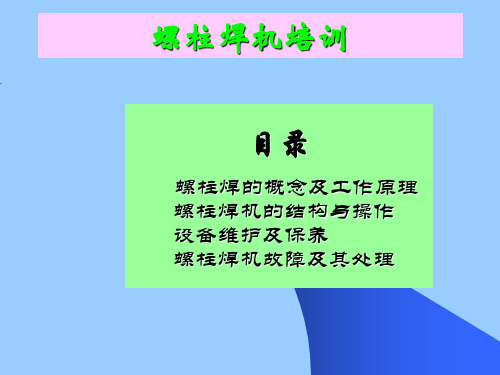
螺柱焊机故障及其处理(续)
故障现象
按动 开关 后不 出钉
故障的原因
气阀开关未被打开 送料器内卡钉 送钉软管内堵钉 收料器内卡钉 送料器坏(有故障号出现)
故障处理
打开气阀 清理送料器 清理送钉软管 清理收料器 复位若不行找维修人员
送料 器不 转动
送料器转盘卡死 送料器边缘卡死 送料器仓盖未盖好 送料器轨道卡钉 电机、转盘连接的轴断 送料器电机坏
短路阶段 起始电流阶段 焊接阶段 浸末阶段
1.短路阶段:焊接工艺的前提条件是焊接螺栓接触
工件表面。以便焊接回路随着启动命令的发出通过 螺栓和工件间发生短路。
2.起始电流阶段:起始电流稳定之后,焊枪的回
程机构使螺栓离开工件,引燃起始电流的电弧。即 引弧。起始电流的电弧是用来引燃主电弧的。
3.焊接阶段:起始电流阶段结束之后接通主焊接电
调整转盘清除异物 取出异物 盖好仓门 清除、调整 更换连接轴 维修电机
4 )打开气源气阀(手动焊枪无需压缩空气), 送料器上压力表指示不 得低于6bar。
螺柱焊机的操作
1.手动焊枪 1) 手动装钉:用手或装钉器将需焊接的螺钉插入导电夹头中,使钉与 导电夹头同轴,并检查螺钉高度是否正常(螺钉约高出导电夹头约 1.2mm); 2) 焊接:将焊枪对准需焊接处(由夹具和焊枪灭弧罩共同保证),使焊 接螺钉与焊接工件焊接面垂直(由夹具和焊枪灭弧罩共同保证),把 焊枪向下直压,使导电夹头向后收缩,再按动焊枪上焊接按钮,随着 清脆的焊接声与弧光,在100ms内完成整个焊接过程。
按动 开关 后不 焊接
焊机在“手动”或“调整”的 状态 出现故障号 开关失灵 地线断 控制线断 垂直灯的接线掉或断 程序出现错误 电源的保险丝断 电路板被烧怀
2024年OTC焊接机器人基本操作培训(增加多场景)
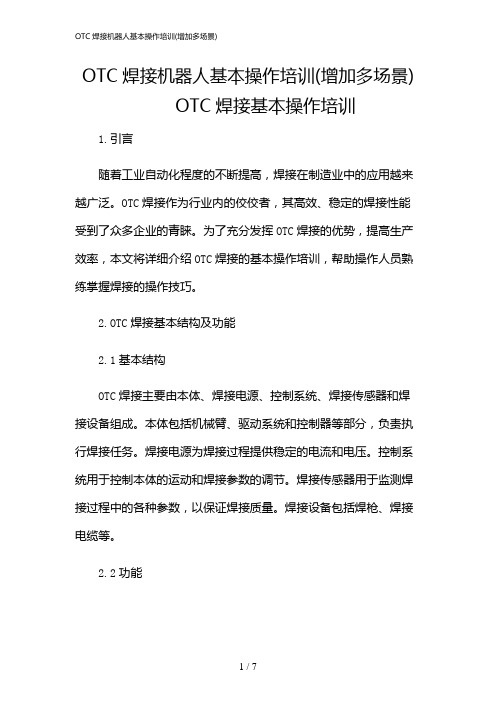
OTC焊接机器人基本操作培训(增加多场景)OTC焊接基本操作培训1.引言随着工业自动化程度的不断提高,焊接在制造业中的应用越来越广泛。
OTC焊接作为行业内的佼佼者,其高效、稳定的焊接性能受到了众多企业的青睐。
为了充分发挥OTC焊接的优势,提高生产效率,本文将详细介绍OTC焊接的基本操作培训,帮助操作人员熟练掌握焊接的操作技巧。
2.OTC焊接基本结构及功能2.1基本结构OTC焊接主要由本体、焊接电源、控制系统、焊接传感器和焊接设备组成。
本体包括机械臂、驱动系统和控制器等部分,负责执行焊接任务。
焊接电源为焊接过程提供稳定的电流和电压。
控制系统用于控制本体的运动和焊接参数的调节。
焊接传感器用于监测焊接过程中的各种参数,以保证焊接质量。
焊接设备包括焊枪、焊接电缆等。
2.2功能(1)自动化焊接:通过编程实现各种焊接工艺的自动化执行,提高生产效率。
(2)稳定焊接质量:采用先进的焊接控制技术和传感器,保证焊接质量的稳定。
(3)灵活编程:可根据焊接任务需求,灵活设置焊接参数和路径。
(4)多样化焊接工艺:支持多种焊接工艺,如气体保护焊、激光焊等。
(5)安全防护:具备安全防护功能,确保操作人员的安全。
3.OTC焊接基本操作培训3.1操作前准备(1)检查设备:检查OTC焊接及其周边设备是否正常,包括电源、气源、冷却水等。
(2)穿戴劳保用品:操作人员需穿戴好劳保用品,如防尘口罩、防护眼镜、防护手套等。
(3)了解焊接任务:了解本次焊接任务的具体要求,包括焊接工艺、焊接材料、焊接参数等。
3.2操作步骤(1)启动设备:按照设备操作规程,依次启动OTC焊接及其周边设备。
(2)编程:根据焊接任务需求,设置焊接参数和路径。
可通过示教器或编程软件进行编程。
(3)调试:在正式焊接前,进行试运行,检查编程是否正确,焊接参数是否合适。
(4)焊接:启动焊接程序,进行自动化焊接。
(5)监控:在焊接过程中,实时监控焊接参数和焊接质量,确保焊接过程稳定。
德国KOCO拉弧式螺柱焊机
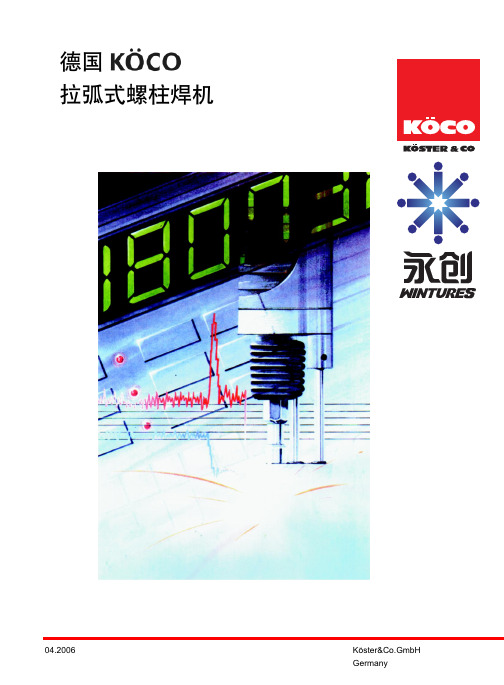
b NOR Q NNMM SNM UNM PUM !"#$%&'()
!"#$%&'(
8
TMMáLNPMMá
!"#$%
!"#$%&'()*+,- !./0 !"#$%&'()*+ ! !"#$% !"#$%& OMheò !"#$%&'() !"#$%& '()*+,-"#$./01
!"#
!"# ! !" !"# ! L !"# ! ! ! ! ! ! ! EããF ç s ^ hs^ ^ éáÉÅÉëLãáåK ëíìÇ ç E^F EãëF sZ
1 3 2(1)
!" N O P
2 3
a)
2 1
#$
b)
3
!"#$ KÖCO !"#
= ! NKNPMP ! bPRRI
2
#$% !"
==NKQPMN
~F= === Ä
!" NM !"#
==bkNMMUUJN
!"
=
^O J RM
!
==fpMPRMS = !"#"$ ==NKQPMNINKQPMPINKQQMNINKQRQNI ==NKQRTN = bkNMMUUJ N = !" pbtQTM ==NKQTNPINKQTQOINKQTSOINKQUOUI
!"#$%&'()*+,
!"#$%&
培训体系CO培训教材
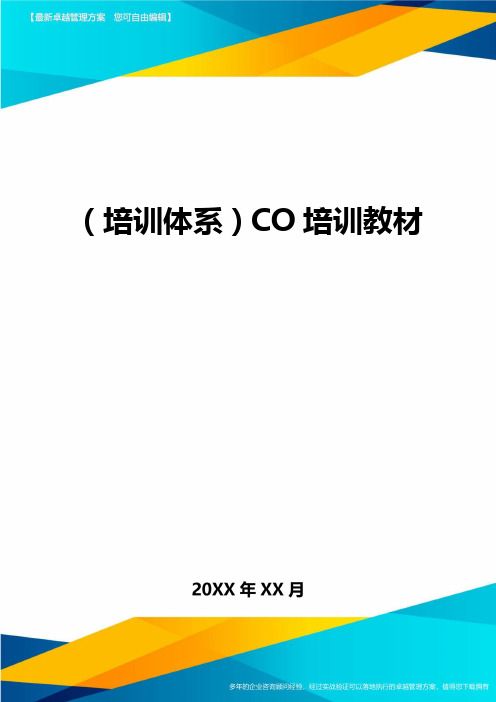
(培训体系)CO培训教材气保焊焊丝按其结构可分为实芯焊丝和药芯焊丝。
实芯焊丝气体保护焊是采用气体保护方式,药芯焊丝气体保护焊是采用气渣联合保护方式。
1、板材和管材焊接位置分类2.1)板材对接接头焊接位置示意图2.2)板材角接接头焊接位置示意图2.3)管材对接接头焊接位置示意图2、焊接电源为直流电弧焊机,当焊件接负极,焊丝接正极时,称为直流反接;当焊件接正极,焊丝接负极时,称为直流正接。
3、焊接裂纹可分为热裂纹、冷裂纹、层状撕裂等。
4、焊缝同壹部位返修次数,不宜超过俩次。
对超过俩次返修的焊接部位,应重新制订专项返修方案,经工程技术负责人审批且报监理工程师认可后方可执行。
5、当采用手工焊或CO2气体保护焊时,有电弧声音大,大颗粒的铁水向容池外飞溅,爆裂声大现象,这说明焊接电流过大。
6、焊接时开坡口的目的主要是为了方便施焊和保证接头质量(保证焊透)。
7、焊接电流主要影响焊缝的熔深,电弧电压主要影响焊缝的熔宽。
8、碳弧气刨壹般采用的电源极性是直流反接。
10、当气保焊机出现送丝不稳、电弧时断时燃、焊丝和熔池发生固体短路等现象时,很有可能是导电嘴不良所引起的。
11、坡口角度于焊接过程中的作用主要是保证焊透及便于清渣等12、焊工停焊时间超过6个月时间应重新考核。
13、当板厚相同时,立焊电流比平焊电流小,例如:CO2气体保护焊壹般立焊、横焊比平焊减少10%-15%。
14、焊接时,CO2气流保护层遭到破坏易产生氮气气孔。
(因为焊接过程中保护层遭到破坏,使大量的空气侵入焊接区,空气中的气体主要是78%氮气,21%的氧气,氧气于高温过程中和合金Si、Mn等进行反应。
于高温过程中熔池对氮的溶解度很大,但当熔池温度下降时,氮于液态金属中的溶解度迅速减小,就会析出大量的氮气,若未能及时逸出熔池,便会产生大量的氮气孔。
氮气孔壹般出当下近焊缝表面的部位,呈蜂窝状分布。
)15、焊接作业环境应符合以下要求:16、气孔的分类气孔从其形状上分,有球状气孔、条虫状气孔;从数量上可分为单个气孔和群状气孔。
螺柱焊接培训

电源过热 (控制板HZG10上的LED1亮表 1. 开机停焊,让风扇保持转动 (控制板HZG10上的LED1亮表 示可控硅整流桥过热,LED2表示变压器 示可控硅整流桥过热,LED2表示变压器 2.降低焊接规格 过热,参见表5 过热,参见表5) 电源掉相 初始电流不足(导致起弧有问题),初 始电流接触器故障,或初始电流保险烧 坏 内部控制故障 更换保险丝(使用延时足够的保险丝)。 确认保险丝容量足够 更换初始电流保险丝(延时足够)。 更换初始电流接触器 更换控制模块
选择参数
• 焊接电流与焊接时间的设置在焊接电源的
控制面板上进行操作。当设置焊接时间时, 请注意长周期 短周期转换开关的位置。在 请注意长周期/短周期转换开关的位置。在 长周期/ 焊接时间的刻度上,实线表示陶瓷环保护 模式的参数,虚线表示短周期模式( 模式的参数,虚线表示短周期模式(有法兰 的焊钉) 的焊钉)焊接的参数。
故障排除
• 如果故障被设备自己检测到,则红色故障
信号灯会亮。这时把电流调节器的指针分 别指向1 别指向1-5的区域,就可以判断故障的原因。 当指针指向某区域时,红灯闪烁,则故障 代码就是该区域的编号,以下是可能的故 障
原因
排除方法
提升线路中电流过大
1.修复或更换控制电缆 1.修复或更换控制电缆 2.修复或更换焊枪 2.修复或更换焊枪
调节标准支撑杆以获得适合的螺柱 凸出长度
注释 1:夹头 2:螺柱 3:支脚组合块 4:陶瓷环夹头 5:标准支撑杆 6:螺丝 L:提升 P:凸出长度 图4:焊枪头组合图
短周期模式下的焊接参数设置
• 短周期模式下的焊接参数设置(有气体保护/无气体保护) 短周期模式下的焊接参数设置(有气体保护/无气体保护) • 当在薄壁工件上焊接螺柱时,焊接热影响区越浅越好。这时,应使用
汽车装焊工艺基础知识

4.5 非焊接工艺参数对焊点强度影响
(1)电极帽形状及材料性能也对焊点强度有一定影响:由 于电极帽的接触面积决定着电流密度,电极帽材料的电阻率和 导热性关系着热量的产生和散失,因此,电极帽的形状和材料 对熔核的形成有显著影响。随着电极帽端头的变形和磨损,接 触面积增大,焊点强度将降低。
(2)工件表面的氧化物、污垢、油和其他杂质增大了接触 电阻。过厚的氧化物层甚至会使电流不能通过。局部的导通, 由于电流密度过大,则会产生飞溅和表面烧损。氧化物层的 存在还会影响各个焊点加热的不均匀性,引起焊接质量波动。 因此彻底清理工件表面是保证获得优质接头的必要条件。
4.10 点焊机结构
点焊机结构由三大部分组成: 电源及控制装置(阻焊控制器) 能量转换装置 (焊接变压器) 焊接执行机构 (点焊钳或点焊枪)
4.11 认识点焊设备
电极帽/杆
机 器 人 主 线 焊 接
机 器 人 主 线 焊 接
5、电阻凸焊
5.1 凸焊的工艺特点
凸焊是点焊的一种变形,通常是在两板件之一上冲出 凸点,然后进行焊接。由于电流集中,克服了点焊时熔 核偏移的缺点,因而凸焊时工件的厚度比可以超过6:1。
η=h/δ-c×100% 两板上的焊透率只允许介于20-80%之间。
镁合金的最大焊透率只允许至60%。而钛合金则允许至 90%。焊接不同厚度工件时,每一工件上的最小焊透率可 为接头中薄件厚度的20%,压痕深度不应超过板件厚度的 15%,如果两工件厚度比大于2:1,或在不易接近的部位 施焊,以及在工件一侧使用平头电极时,压痕深度可增大 到20-25%。
二氧化碳气体保护焊示意图
焊丝
CO2气体 熔池 焊件
电弧 焊件
Hale Waihona Puke 6.2 二氧化碳保护焊参数 焊丝直径 焊接电流 电弧电压
培训焊工理论培训CO气体保护焊PPT学习教案
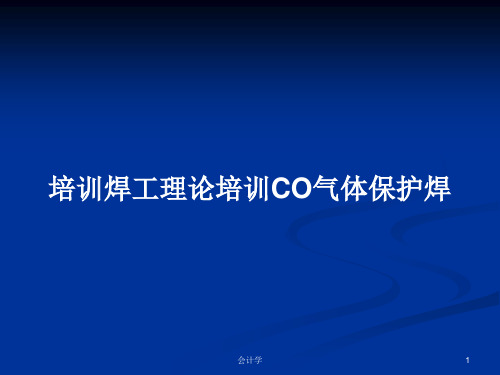
送丝轮槽型的比较
U型轮:送丝轮和焊丝面接触 ,送丝力量大,对焊丝的损 伤最小,适合各种实芯和药 芯焊丝。 V型轮:送丝轮和焊丝点接触 ,压力小时送丝力量小,易 打滑,压力大时,会引起焊 丝变型。
第20页/共57页
送丝比较
H08Mn2SiA:材质硬,不易变形,送 丝阻力小,送丝机送丝容易。
焊丝
CO2焊丝分实芯和药芯焊丝两种. 型号:H08Mn2SIA 优质焊丝 规格 : 直径 0.6 0.8 0.9 1.0 1.2 1.6
第25页/共57页
CO2焊用的主要焊丝品种
C目O(2焊镀用铜的层主附要着焊力丝和品焊种丝是松H弛08直M径n2S及i类扰型距。)根又据分其为杂四质种含。量(S和P)和检查项 H08Mn2SiA:与H08Mn2Si比冲击值高,送丝均匀,导电好。 H的0大4M电n2流SiT。iA: 脱氧能力强,脱氮能力强,抗气孔能力强,使用于200A以上 H于0大4M电n2流SiA填lT充iA(: 水脱平氧)能和力C更O强2-A,r2脱混氮合能气力体更保强护,焊抗。气孔能力更强,特别使用 MAG: H08MnSiA
第9页/共57页
药芯焊丝的特点
比实心焊丝能量集中
焊接质量好
飞溅少,焊缝成型好
效率高
节能
综合成本低
调节熔敷成分方便
不增碳
第10页/共57页
焊机种类的特征
焊枪行走
送丝(条)
手工焊 人工
人工
半自动
(CO2)
自动
人工
自动 自动
第11页/共57页
(埋弧焊)
自动
正确使用焊机
第12页/共57页
第30页/共57页
CO2气:
《螺柱焊培训》课件

螺柱焊的操作流程包括准备工作、设备调试、焊接参数设置、工件定位以及焊接 完成后的检验。
3
螺柱焊设备的维护
定期对螺柱焊设备进行维护保养,包括清洁设备、更换磨损部件、保养电源等, 以确保设备的正常运行。
三、螺柱焊缺陷及其处理方法
1 螺柱焊缺陷分类
常见的螺柱焊缺陷包括错 位焊、错边焊、气孔等, 这些缺陷会影响连接件的 强度和密封性。
《螺柱焊培训》PPT课件
欢迎来到本次《螺柱焊培训》PPT课件。在这里,您将掌握螺柱焊的基本原理、 设备操作、缺陷处理、安全注意事项以及案例分析,并展望其发展前景。
一、螺柱焊的基本原理
螺柱焊的定义
螺柱焊是一种通过电弧熔化螺栓与工件表面, 将螺栓与工件进行连接的焊接方法。
螺柱焊的特点
螺柱焊具有焊接速度快、焊接强度高、焊接质 量稳定等特点,适用于大批量焊接工艺。
螺柱焊的分类
根据工艺参数和焊接方式,螺柱焊可分为手工 螺柱焊、自动螺柱焊和半自动螺柱焊。
螺柱焊的应用
螺柱焊广泛应用于汽车制造、船舶建造、桥梁 建设等领域,用于工件的连接和固定。
二、螺柱焊设备及操作
1
螺柱焊设备的组成
螺柱焊设备包括焊接机器、电源供应、焊接枪、控制器等,确保焊接过程的稳定 和高效。
2
螺柱焊操作流程
螺柱焊过程中的注意 事项
操作螺柱焊时,应注意电流电 压的选择、焊接材料的质量以 及焊接过程中的熔融污染等问 题。
螺柱焊设备的安全操 作规程
制定螺柱焊设备的安全操作规 程,培训操作人员,确保设备 操作过程安全可靠。
五、螺柱焊案例分析
螺柱焊在工业生产中的应 用案例
和汽车制造相结合,螺柱焊应用 在车身焊接、发动机连接等领域, 提高了生产效率和产品质量。
- 1、下载文档前请自行甄别文档内容的完整性,平台不提供额外的编辑、内容补充、找答案等附加服务。
- 2、"仅部分预览"的文档,不可在线预览部分如存在完整性等问题,可反馈申请退款(可完整预览的文档不适用该条件!)。
- 3、如文档侵犯您的权益,请联系客服反馈,我们会尽快为您处理(人工客服工作时间:9:00-18:30)。
德国KOCO螺柱焊机焊接培训
2008/10/30
螺柱焊接可以采用柔性电缆从单面焊接紧固件,在现代工业制造中得到了越来越多地应用。
根据焊接原理和主机电源的类型的区别,分为拉弧式和电容储能式两种,但总的来说,它们都属于弧焊的一种,都是采用瞬间电弧将焊接螺柱底部和工件表面熔化,并与工件形成永久连接。
我们车间使用的是德国KOCO拉弧式螺柱焊机,而且是使用短周期拉弧焊接模式,短周期拉弧式螺柱焊接就是专门为汽车制造焊接螺柱而创新的。
汽车行业需要将螺柱焊接在薄板上,包括普通板和镀锌板,而且要求焊接强度能适应汽车的长期运动、震动,在短周期拉弧式螺柱焊接发明之前,这是很难实现的。
我先说说短周期螺柱焊钉的特点,他的焊接头部标准是中心突出的一个锥面,锥面与中心线的垂直线的夹角标准是7度(正负1度),只有保证这个焊接头部形状,才能保证好的焊接效果。
注意区别点焊螺钉,他的焊接头部是平面上均匀分布3个小突起。
我们还注意到,在实际应用中,还有一种特种T形钉,它的头部是平的,仍然可以焊接得比较好,这是一个特例,能取得好的焊接效果,和它的焊接直径特别小相关。
下面我讲讲焊接参数的调节。
拉弧式螺柱焊接主要就是的4项
调节参数:焊接电流、焊接时间、突出长度、提升高度。
其中焊接电流和焊接时间是在焊机上调节的,螺钉的突出长度和提升高度是在焊枪上调节的。
现在每台焊机的焊接参数我已经贴在每台焊机的机身上了,大家可以参照调节。
我特别说明一下提升高度,作为弧焊的一种,拉弧式螺柱焊就是利用焊枪的提升,造成螺柱与工件的高度差来产生电弧的,如果没有提升高度,就不会有焊接。
我们使用的SK14焊枪,它的实际提升高度=焊枪尾部的参数+1-突出长度,通常我们建议实际提升高度1.5—2.0,即我们选择焊枪尾部的标称提升高度3.5,螺钉的突出长度选择2.5—3;如果突出长度你调得特别长,达到了4.5,那你将焊枪完全压住后,焊枪就提升不了了,也就不能焊接了。
还要注意一点,尾部的参数是按档位调节的,不能选择3和3.5之间;大家反映,可能有几把焊枪,尾部的参数锁不紧,那是因为调节盘侧面的锁紧螺钉松了,只需要用一把小的一字螺丝刀,就可以旋紧了。
我们进行螺柱焊接,偏弧是经常遇到的,在国际标准ISO14555中,就专门说明了偏弧产生的原因和调节方法。
其中最主要的3点,第一点就是大的金属件对电弧的吸引,电弧会偏向大的金属件中心,必要时要配置均衡块;第二点焊枪电缆和接地电缆对电弧的推斥,所以我们要均衡、对称的配置地线,还要注意,如果焊瘤总是在焊枪电缆的反方向,就应该考虑焊接时旋转一下焊枪电缆的方向;第三点,提升高度过高时,就是说电弧高度过高,电弧容易被偏吹,这是我们可以适当降低提升高度。
顺便说说特别要注意的一个地方,就是此批焊机的面板保险管套是卡槽式的,在取出或者放入保险丝时,旋转前都必须先压入3mm 左右,再进行旋转;如果不压入3mm,强行直接旋转,就会损坏保险管套。
